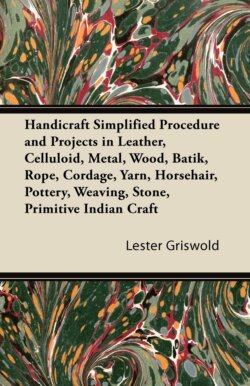Читать книгу Handicraft Simplified Procedure and Projects in Leather, Celluloid, Metal, Wood, Batik, Rope, Cordage, Yarn, Horsehair, Pottery, Weaving, Stone, Primitive Indian Craft - Lester Griswold - Страница 13
На сайте Литреса книга снята с продажи.
Belts, Hatbands, Dog Collars
Оглавление7.A Stamped or Carved Belt of natural cowhide or vealskin (vegetable tanned, unglazed) is readily made after the detail of stamping and carving has been mastered as described on pages 53 to 58.
a.Carefully bevel the edges, dampen and crease as in previous strap leather projects. Omit the beveling for vealskin.
b.Plan a suitable stamped or carved motif for the section which will be the center of the back. A group of belt panels is illustrated above. A carved design requires a tracing which is transferred to the dampened surface of the leather as described on page 53. Stamped designs should be planned on paper so that the space will not be crowded, and the designs balanced for arrangement.
c.Apply the decoration and permit the belt to dry flat.
Polish the surface and edges, using a leather dressing.
d.If a dyed leather has keen used, the final step before polishing is to stain the light edges.
e.Attach the buckle using the three hole fastening described on page 81.
A Dog Collar, several styles of Hatbands and a Three-Strand Endless Braid Strap, are illustrated above.
8.Dog Collars are usually decorated with metal ornaments, with buckle and dee fastening as illustrated. The method of attaching metal ornaments is shown on page 62.
9.Hat Bands are decorated in the same manner as belts. Methods of attaching the buckles or deer with the three hole fastening is detailed on pages 37 and 81. The cinch type fastening for a hatband is shown in Sketch HC.
A buckleless belt is shown in Photograph B. One end of the belt is shaped with three notches on each side. The other end contains a wedge shaped slit. Insert the notched end of the belt in the opening and rotate the two ends until the space between the notches rest against the end of the wedge shaped slit.
The construction of belts split three strand for endless braiding is described on page 84.
10.Note Book Covers may be made of 4 oz. cowhide, tooling veal-skin, or tooling steer. Unlined Cowhide may be used with the rivet type note book metal. Other leathers should be lined. The illustration shows left to right: 4 oz. Cowhide with tooled decoration, Vealskin, with Girl Scout emblem tooled and Steerhide, also tooled.
a.After the decoration is applied the outside piece should be folded before it is dry so that it will be flat. A fold of paper or cardboard about the size of the note book leaves may be placed between the covers until the leather dries.
b.Attach the metal to the cowhide with rivets as detailed on page 79, or if a lining is used follow the instruction for attaching base plate metal on page 79.
c.Assemble with wide lacing starting near the top of a pocket.
